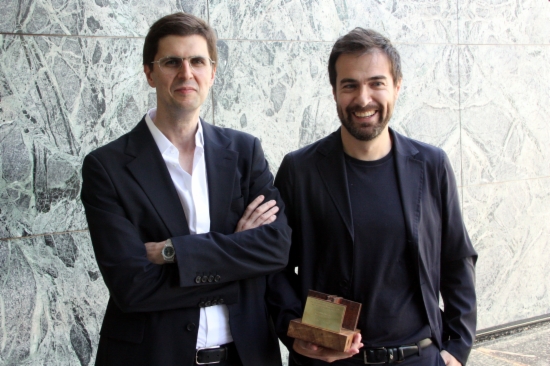Szczecin's Philharmonic Hall designed by two Barcelona-based architects wins EU Prize for Contemporary Architecture
The Mies van der Rohe Award is the Catalan capital-based European Union Prize for Contemporary Architecture, which is among the world's most prestigious awards in this field. It is named after the architect who designed the German Pavilion for the 1929 Barcelona International Exhibition. At each of its biennial editions, two works are awarded: one with the EU Prize for Contemporary Architecture and the other with the Emerging Architect Special Mention. For this year, the Philharmonic Hall of Szczecin (Poland) designed by Barcelona-based architects Alberto Veiga (Spain, 1973) and Fabrizio Barozzi (Italy, 1976) has been announced as the prize winner. The work was realised in collaboration with Studio A4. The Catalan ARQUITECTURA-G has obtained the Emerging Architect Award with the work 'Luz House'. The winners were chosen from a list of 420 works from 36 European countries.

Barcelona (ACN).- The Mies van der Rohe Award is the Catalan capital-based European Union Prize for Contemporary Architecture, which is among the world's most prestigious awards in this field. It is named after the architect who designed the German Pavilion for the 1929 Barcelona International Exhibition. At each of its biennial editions, two works are awarded: one with the EU Prize for Contemporary Architecture and the other with the Emerging Architect Special Mention. For this year, the Philharmonic Hall of Szczecin (Poland) by Barcelona-based architects Alberto Veiga (Spain, 1973) and Fabrizio Barozzi (Italy, 1976) has been announced as the prize winner. The work was realised in collaboration with Studio A4. The Catalan ARQUITECTURA-G obtained the Emerging Architect Award with the work 'Luz House'. The winners were chosen from a list of 420 works from 36 European countries.
The new Philharmonic Hall in Szczecin is located on the historical site of the "Konzerthaus", which was destroyed during the Second World War and recomposes an urban corner in a neighbourhood near to the historic city. Antoni Vives, Deputy Mayor of Barcelona, stressed that the Mies Van Der Rohe Award not only rewards the aesthetic of the work but also the intrinsic value of it. "The importance of giving the award to a building located in Poland, designed by Galician and Italian architects based in Barcelona crystallises the spirit of it".
In its use of materials, the building is perceived as a light element: the glass facade, illuminated from inside, depending on the use, allows different perceptions. The exterior’s austerity and the simple composition of the interior circulation spaces contrast with the expressiveness of the main hall. In accordance with the central European tradition of the classical concert halls, decoration becomes ornament and function. The building houses a symphony hall for 1,000 spectators, a hall for chamber music for 200 spectators, a multifunctional space for exhibitions and conferences, and a wide foyer.
The winners highlighted that the last few years, especially since 2008, have been an extremely hard times for all architects due to the financial crisis and the bursting of the construction bubble, but luckily they have overcome this difficult phase. "We wish to continue working, doing what we like to do and continuing to grow as professional architects", Alberto Veiga underlined.
The best among 420 projects
The winner was chosen from a list of 420 works from 36 European nations and five finalists were selected: Ravensburg Art Museum by Lederer Ragnarsdóttir Oei; the Danish Maritime Museum in Helsingør by BIG - Bjarke Ingels Group; Antinori Winery in Bargino-San Casciano Val di Pesa, Florence, by Archea Associati; Szczecin Philharmonic Hall by Barozzi/Veiga and the Saw Swee Hock Student Centre - London School of Economics, in London, by O'Donnell + Tuomey.
The Emerging Architect Prize was awarded to the Catalan studio ARQUITECTURA-G for their work 'Luz House', a single-family house born from the transformation of an existing structure in the Spanish town of Cilleros, in Extremadura. According to the jury, "the designers understood well and solved brilliantly the constructive and economic constraints of the project". Jordi Ayala, a member of ARQUITECTURA-G, explained that the work was aimed at offering the customer the opportunity to profit from a building of historical interest in a very bad state. "Winning a European prize awarded by a foundation located here in Barcelona makes us feel particularly proud and enthusiastic because of the bond we have with the foundation itself", he said.
The Award aims to foster circulation of professional architects and emerging ones
The Mies van der Rohe Award aims to foster greater circulation of professional architects throughout the European Union and support emerging architects. Candidates for the Award are put forward by a broad group of independent experts from all over Europe, as well as from the architects’ associations that form part of the European Council of Architects and other European national architects’ associations. The Award consists of a cash prize of €60,000 while the Special Mention is endowed with €20,000. From 2015 onwards, the ‘Young Talent Internship’ will allow a recently graduated architect to work in the Prize Winner’s office for one year.